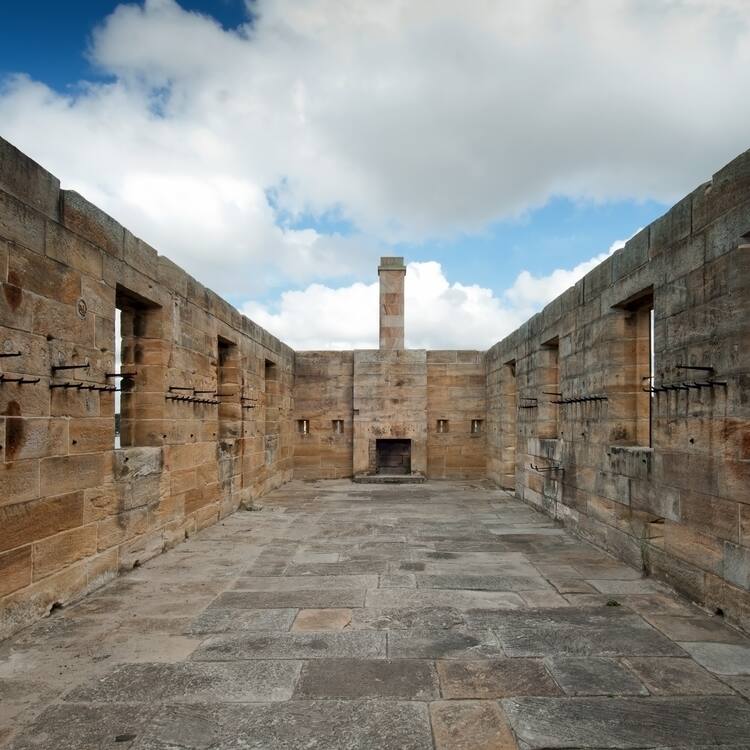Australian Convict Sites
Australian Convict Sites
The property includes a selection of eleven penal sites, among the thousands established by the British Empire on Australian soil in the 18th and 19th centuries. The sites are spread across Australia, from Fremantle in Western Australia to Kingston and Arthur's Vale on Norfolk Island in the east; and from areas around Sydney in New South Wales in the north, to sites located in Tasmania in the south. Around 166,000 men, women and children were sent to Australia over 80 years between 1787 and 1868, condemned by British justice to transportation to the convict colonies. Each of the sites had a specific purpose, in terms both of punitive imprisonment and of rehabilitation through forced labour to help build the colony. The Australian Convict Sites presents the best surviving examples of large-scale convict transportation and the colonial expansion of European powers through the presence and labour of convicts.
Description is available under license CC-BY-SA IGO 3.0
Sites de bagnes australiens
Le bien comprend une sélection de onze sites pénitentiaires, parmi les milliers établis par l'Empire britannique sur le sol australien aux XVIIIe et XIXe siècles. Les sites sont disséminés à travers le pays, de Fremantle en Australie occidentale, à Kingston et Arthur's Vale sur l'île de Norfolk, à l'est ; et des environs de Sidney, en Nouvelle-Galles du Sud, au nord, jusqu'aux sites de Tasmanie, au sud. Près de 166 000 hommes, femmes et enfants furent envoyés en Australie pendant plus de 80 ans, entre 1787 et 1868, condamnés par la justice britannique à la déportation dans les colonies pénitentiaires. Chacun des sites avait une vocation propre, qu'il s'agisse d'enfermement punitif ou de rééducation par le travail forcé au service du projet colonial. Le bien présente les meilleurs exemples survivants de la déportation à grande échelle de condamnés et de l'expansion colonisatrice des puissances européennes par la présence et le travail des bagnards.
Description is available under license CC-BY-SA IGO 3.0
مواقع سجون المنافي
يشمل هذا الموقع مجموعة مختارة من الإصلاحيات من بين آلاف الإصلاحيات التي أنشأتها الإمبراطورية البريطانية في أستراليا إبان القرن الثامن عشر والقرن التاسع عشر. وتقع هذه الإصلاحيات على المحيط البحري الخصيب الذي طُرد منه السكان الأصليون، وبصفة أساسية حول مدينة سيدني وفي جزيرة تاسمانيا وجزيرة نوفولك ومدينة فريمانتل. وضمت هذه السجون عشرات الآلاف من الرجال والنساء والأطفال الذين أدانتهم المحاكم البريطانية. وكان لكل موقع من هذه المواقع اختصاص معين، كالحبس العقابي أو إعادة التهذيب عن طريق تطبيق الأشغال الشاقة لصالح المشروع الاستعماري. ويقدم الممتلك أفضل الأمثلة الباقية على عمليات نفي المجرمين على نطاق واسع، وعلى التوسع الاستعماري الذي مارسته القوى الأوروبية باستخدام المحكوم عليهم بالأشغال الشاقة.
source: UNESCO/CPE
Description is available under license CC-BY-SA IGO 3.0
澳大利亚监狱遗址
18世纪和19世纪时,大英帝国在澳大利亚设立了数千所监狱。“澳大利亚监狱遗址”选取了其中的11座殖民监狱。它们主要位于悉尼附近和塔斯马尼亚岛上,但也有几所设在诺福克岛和弗里曼特尔市,其所在地大多是原住民已被驱逐了的、肥沃的海岸地区。这些监狱关押过被英国法院放逐到澳洲殖民地的成千上万名男性、女性和儿童。每座监狱都有自身的用途,它们或是惩罚性的监禁,或是让犯人通过劳动教养协助殖民的建设。“澳大利亚监狱遗址”是现存的大规模驱逐罪犯出境以及欧洲列强通过流放犯人和强制劳动进行殖民扩张的最佳例证。
source: UNESCO/CPE
Description is available under license CC-BY-SA IGO 3.0
Каторжные поселения
Памятник включает в себя 11 лагерей, отобранных среди тысяч тех, что были созданы Британской империей в Австралии в 18-19 веках. Они расположены по плодородной периферии моря, откуда были вытеснены аборигены, главным образом вокруг Сиднея и на острове Тасмания, а также на острове Норфолк и в районе города Фримэнтл. В этих тюрьмах содержались десятки тысяч мужчин, женщин и детей, приговоренных британским правосудием к тарнспортировке в каторжные колонии. Каждое учреждение отличалось своей спецификой – одни были местом тюремного заключения, другие служили перевоспитанию принудительным трудом, плодами которого пользовалась колониальная администрация. Памятник сохранил красноречивые свидетельства крупномасштабной депортации преступников и колониальной экспансии европейских держав за счет размещения там заключенных и эксплуатации их труда.
source: UNESCO/CPE
Description is available under license CC-BY-SA IGO 3.0
Sitios australianos de presidios
Este sitio comprende un grupo constituido tan sólo por once de los varios miles de colonias penitenciarias que el Imperio Británico estableció en Australia durante los siglos XVIII y XIX. Están situadas en el contorno marítimo fértil del que fueron expulsados los aborígenes, principalmente en los alrededores de las ciudades de Sydney y Fremantle, así como en las islas de Tasmania y Norfolk. En estos presidios vivieron decenas de miles de hombres, mujeres y niños condenados por la justicia británica. Tenían por finalidad específica el encarcelamiento punitivo de los presidiarios, o su reeducación mediante la realización de trabajos forzados en beneficio de los proyectos coloniales. Estos sitios constituyen los mejores ejemplos subsistentes del fenómeno de la deportación masiva de delincuentes y de la expansión de las potencias coloniales europeas mediante la explotación de mano de obra reclusa.
source: UNESCO/CPE
Description is available under license CC-BY-SA IGO 3.0
オーストラリア囚人遺跡群
source: NFUAJ
Australische gevangenisterreinen
Source: unesco.nl
Outstanding Universal Value
Brief synthesis
The property consists of eleven complementary sites. It constitutes an outstanding and large-scale example of the forced migration of convicts, who were condemned to transportation to distant colonies of the British Empire; the same method was also used by other colonial states.
The sites illustrate the different types of convict settlement organized to serve the colonial development project by means of buildings, ports, infrastructure, the extraction of resources, etc. They illustrate the living conditions of the convicts, who were condemned to transportation far from their homes, deprived of freedom, and subjected to forced labour.
This transportation and associated forced labour was implemented on a large scale, both for criminals and for people convicted for relatively minor offences, as well as for expressing certain opinions or being political opponents. The penalty of transportation to Australia also applied to women and children from the age of nine. The convict stations are testimony to a legal form of punishment that dominated in the 18th and 19th centuries in the large European colonial states, at the same time as and after the abolition of slavery.
The property shows the various forms that the convict settlements took, closely reflecting the discussions and beliefs about the punishment of crime in 18th and 19th century Europe, both in terms of its exemplarity and the harshness of the punishment used as a deterrent, and of the aim of social rehabilitation through labour and discipline. They influenced the emergence of a penal model in Europe and America.
Within the colonial system established in Australia, the convict settlements simultaneously led to the Aboriginal population being forced back into the less fertile hinterland, and to the creation of a significant source of population of European origin.
Criterion (iv): The Australian convict sites constitute an outstanding example of the way in which conventional forced labour and national prison systems were transformed, in major European nations in the 18th and 19th centuries, into a system of deportation and forced labour forming part of the British Empire’s vast colonial project. They illustrate the variety of the creation of penal colonies to serve the many material needs created by the development of a new territory. They bear witness to a penitentiary system which had many objectives, ranging from severe punishment used as a deterrent to forced labour for men, women and children, and the rehabilitation of the convicts through labour and discipline.
Criterion (vi): The transportation of criminals, delinquents, and political prisoners to colonial lands by the great nation states between the 18th and 20th centuries is an important aspect of human history, especially with regard to its penal, political and colonial dimensions. The Australian convict settlements provide a particularly complete example of this history and the associated symbolic values derived from discussions in modern and contemporary European society. They illustrate an active phase in the occupation of colonial lands to the detriment of the Aboriginal peoples, and the process of creating a colonial population of European origin through the dialectic of punishment and transportation followed by forced labour and social rehabilitation to the eventual social integration of convicts as settlers.
Integrity and authenticity
The structural and landscape integrity of the property varies depending on the site, and on the type of evidence considered. It has been affected by local history, at times marked by reuse or lengthy periods of abandonment. The integrity varies between well preserved groups and others where it might be described as fragmentary. Apart from certain visual perspectives in urban settings, the level of the property’s integrity is well controlled by the site management plans.
Despite the inevitable complexity of a nomination made up of a series of eleven separate sites with more than 200 elements that convey the value of the property, the authenticity of the vast majority of them is good.
Protection and management requirements
All the sites forming the property are inscribed on the National Heritage List. They are also protected by the Environment Protection and Biodiversity Conservation Act 1999.
There is no direct major threat to the sites forming the serial property.
The general protection and management of the property are satisfactory. Conservation is articulated around a positive dynamic driven by the application of the conservation plans at each of the sites. The Brickendon and Woolmers Estate domains are an exception, and require ongoing assistance, both in terms of protection and conservation.
The management systems of the sites forming the property are appropriate, and they are adequately coordinated by the Strategic Management Framework for the property and its Steering Committee. For the sites involving the participation of private stakeholders for visitor reception, improved interpretation is however necessary; that includes the common objectives outlined in the Strategic Management Framework. It is also important to consider visitor reception facilities and their development in a way which respects the landscape conservation of the sites.

